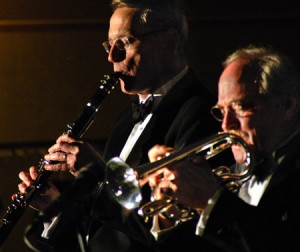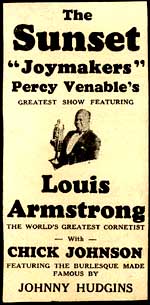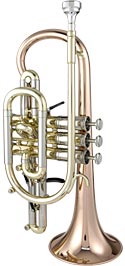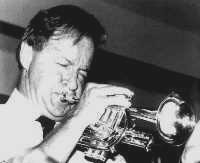For over 50 years The Jim Cullum Jazz Band has performed its repertoire with an authentic early jazz sound as played in the first half of the 20th century before WWII. This sound differs from more modern-style jazz, in part, because Jim and the Band favor period instruments such as the clarinet, banjo, Chinese drum, slapped double bass with gut strings, and, above all—the cornet.
Long before jazz found its way into the public eye, the cornet reigned supreme as the soprano brass solo instrument of choice. Late 19th-century virtuosos like Herbert L. Clarke with the John Phillip Sousa US Marine Band dazzled mainstream audiences with their seemingly superhuman performances of showcase pieces like "Variations on the Carnival of Venice" and "Maid of the Mist."
Early 20th century jazz inherited the widespread affection American audiences had for the brass band sound and the culture of the cornet. The playing of jazz cornet pioneers Buddy Bolden, Freddy Keppard and Joe "King" Oliver differed from their brass band counterparts with their strong sense of swing and a talent for the blues.
In 1922 young Louis Armstrong joined Joe Oliver in Chicago and they both played cornet while headlining at the Lincoln Gardens. A few years later, the cornet was already beginnning to go out of fashion. Armstrong joined Fletcher Henderson in 1925 in New York, and his east coast bandmates convinced him to make the switch to trumpet to better blend in with the band sound. On his return to Chicago the following year, Armstrong began to make jazz history with his fiery Hot 5 and Hot 7 recordings on trumpet. He never again recorded on cornet.
Bix Beiderbecke also launched his career playing the cornet, and stayed with it for the rest of his professional life.
By the early 30s, the trumpet had supplanted the cornet in jazz. Among modern players, only Nat Adderly chose the cornet as his main instrument.
The heated debate of the 20s between proponents of cornet versus trumpet appears silly today in the light of the recorded output of trumpeters from Louis Armstrong onward. Cornet star Herbet L. Clarke wrote this letter in 1921:
"...would not advise you to change from Cornet to Trumpet, as the latter instrument is only a foreign fad for the time present, and is only used properly in large orchestras of 60 or more, for dynamic effects, and was never intended as a solo instrument.
"I never heard of a real soloist playing before the public on a Trumpet. One cannot play a decent song even properly on it, and it has sprung up in the last few years like 'jazz' music, which is nearest Hell, or the Devil, in music. It pollutes the art of Music."
The cornet and trumpet play the same notes and look very similar. The difference is in the shape of the tubing—cone vs. cylinder—which produces a difference in the sound quality, or timbre. Think of cones as omni-directional "woofers" and cylinders as highly focused, directional "tweeters." Brass instruments are on a continuum between the two shapes. The most conical brass is the French horn and the most cylindrical is the trombone. When a modern-style jazz player like Clark Terry wants a mellower, "woofy" sound, he will typically go with the flugelhorn, which is even more conical than the cornet.
Jim Cullum specializes in the cornet, and not long before this recorded concert went back to his old standby Getzen, though in recent years he has explored the Conn Victor, the same model used by Bix Beiderbecke and Max Kaminsky, among others. Jim has numerous horns to choose from in his collection, many are antiques dating from the early 20th century.
On this radio show, Bay Area cornetist and trumpeter Leon Oakley joins Jim Cullum and his Band for an exploration of both instruments. Leon was a longtime member of Turk Murphy's band, and has led his own groups. On Friday nights, Leon often holds forth with the Café Borrone All-Stars in Menlo Park, California.
Photo credit for home page teaser image: Bandleader and cornetist Jim Cullum, 2007. Photo courtesy Rivewalk Jazz
Text based on Riverwalk Jazz script by Margaret Moos Pick ©2008






